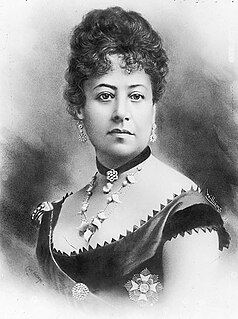
Lunalilo, born William Charles Lunalilo, was the sixth monarch of the Kingdom of Hawaii from January 8, 1873 until February 3, 1874. Due to his popularity and status as Hawaii's first elected monarch, he became known as "The People's King".

Mauna ʻAla in the Hawaiian language, is the Royal Mausoleum of Hawaii and the final resting place of Hawaii's two prominent royal families: the Kamehameha Dynasty and the Kalākaua Dynasty.

Kawaiahaʻo Church is a historic Congregational church located in Downtown Honolulu on the Hawaiian Island of Oʻahu. The church, along with the Mission Houses, comprise the Hawaiian Mission Houses Historic Site, which was designated a U.S. National Historic Landmark (NHL) in 1962. In 1966 it and all other NHLs were included in the first issuance of the National Register of Historic Places.

The Cathedral Church of Saint Andrew, also commonly known as St. Andrew's Cathedral, is a cathedral of the Episcopal Church in the United States located in the State of Hawaii. Originally the seat of the Anglican Church of Hawaii, it is now the home of the bishop of the Episcopal Diocese of Hawaii. It is affiliated with St. Andrew's Schools, which consists of the main girls' K-12 school, the coeducational Queen Emma Preschool and a boys' preparatory school (elementary).
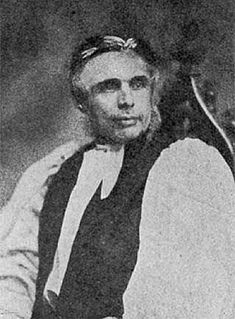
Thomas Nettleship Staley was a British bishop of the Church of England and the first Anglican bishop of the Church of Hawaii.

Prince Albert Kamehameha, formally Albert Edward Kauikeaouli Kaleiopapa a Kamehameha, was the only son of Kamehameha IV and Queen Emma, who during his short life was the Crown Prince of the Kingdom of Hawaiʻi. He was the godson of Queen Victoria.
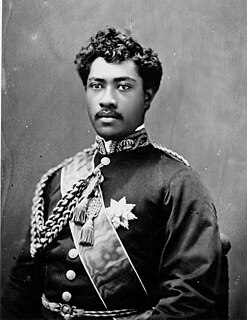
William Pitt Leleiohoku II, born Kalahoʻolewa, was a prince of the Kingdom of Hawaiʻi and member of the reigning House of Kalākaua. At birth, he was hānai by Ruth Keʻelikōlani and later legally adopted by her in 1862 as the heir to her vast land holdings. He was educated at St. Alban's College, a precursor of the present ʻIolani School. After finishing his education, he worked in the governmental Foreign Office and served as an officer on the personal military staff of King Lunalilo. On February 14, 1874, his brother Kalākaua was elected king after the death of Lunalilo. Declared heir apparent to his childless brother, Leleiohoku was expected to inherit the throne of Hawaii. He would also serve as a Privy Councilor and member of the House of Nobles in the Legislature of the Kingdom of Hawaii. During Kalākaua's trip to the United States to negotiate the Reciprocity Treaty of 1875, he ruled as regent in the monarch's absence from November 17, 1874, to February 15, 1875. Leleiohoku died at the age of 22 from rheumatic fever resulting in the proclamation of his sister Liliʻuokalani as the next heir to the throne. An accomplished musical composer, Leleiohoku is remembered for composing many folk songs including "Kāua I Ka Huahuaʻi", which was adapted into the American popular song "Hawaiian War Chant".

Hānaiakamalama or Queen Emma Summer Palace, served as a retreat for Queen Emma of Hawaii from 1857 to 1885, as well as for her husband King Kamehameha IV, and their son, Prince Albert Edward. It is a now a historic landmark, museum, and tourist site located at 2913 Pali Highway, less than a ten-minute drive outside of downtown Honolulu, Hawaii. The museum is open daily from 9:00 a.m. to 4:00 p.m., and is maintained with entrance fees, revenue from the gift shop, and other funds raised by the Daughters of Hawaii.

The Episcopal Diocese of Hawai'i is the ecclesiastical territory or diocese of the Episcopal Church of the Anglican Communion in the United States encompassing the state of Hawaii. It is led by the Episcopal Bishop of Hawaii pastoring the Hawaiian Islands from the Cathedral Church of Saint Andrew in Honolulu.

Elizabeth Kekaʻaniau Laʻanui Pratt, full name Elizabeth Kekaʻaniauokalani Kalaninuiohilaukapu Kekaikuihala Laʻanui Pratt, was a Hawaiian high chiefess (aliʻi) and great-grandniece of Kamehameha I, being a great-granddaughter of Kalokuokamaile, the older brother of Kamehameha I, founder of the Kingdom of Hawaii. She was the daughter of Gideon Peleʻioholani Laʻanui and Theresa Owana Kaheiheimalie Rives.
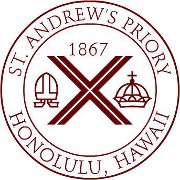
St. Andrew's Priory School is a private all-girls college preparatory school in Honolulu, Hawaii. Founded in 1867 by Queen Emma Kaleleonālani, wife of King Kamehameha IV, the school enrolls students in kindergarten through grade 12. The enrollment is 550, with a student-teacher ratio of 8 to 1. Today, the school is affiliated with the Episcopal Church. It is administered by a Board of Trustees and is the oldest all-girls school in Hawai'i. More than half the faculty have advanced degrees and virtually 100% of graduates attend four-year colleges and universities across the country.

Robert Crichton Wyllie was a Scottish physician and businessman. He also served two decades as Minister of Foreign Affairs in the Kingdom of Hawaii.
Kalanimālokuloku-i-Kepoʻokalani Keliʻimaikaʻi was a High Chief and the most popular brother of Kamehameha the Great, who founded the Kingdom of Hawaii.

Albert Kūkaʻilimoku Kūnuiākea was the illegitimate son of King Kamehameha III and his mistress Jane Lahilahi. He served as the politician in the Kingdom of Hawaii and the Republic of Hawaii. He later was baptized into the Anglican Church of Hawaii with the name Albert Fredrick Kunuiakea Oiwiaulani Koenaokalani.
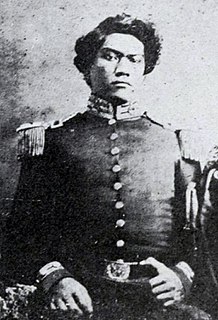
William Hoapili Kaʻauwai was a Hawaiian high chief and politician, and religious deacon of the Kingdom of Hawaii. He served two terms as a member of the House of Representatives of the Legislature of the Kingdom in 1862 and 1870. He became the only Native Hawaiian to be ordained a priest of the Anglican Church of Hawaii and traveled with its founder Queen Emma to Europe between 1865 and 1866, circumnavigating the globe upon his return eastward via New Zealand.
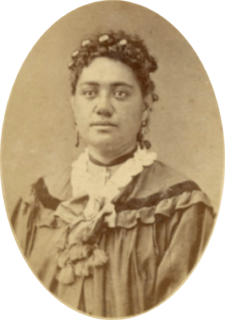
Mary Ann Kiliwehi Kaʻauwai was a Hawaiian high chiefess and lady-in-waiting of the Kingdom of Hawaii. Alongside her husband William Hoapili Kaʻauwai, she traveled with Queen Emma of Hawaii to Europe between 1865 and 1866, and circumnavigated the globe upon their return eastward via New Zealand.
Keanolani was a Hawaiian chiefess (aliʻi) of the Kingdom of Hawaii. She was the illegitimate daughter of Abigail Maheha and King Kamehameha V, who reigned from 1863 to 1872, and was born during a liaison between the two when they were students at the Chiefs' Children's School, a boarding school run by American missionaries for students of Hawaiian royal descent. Keanolani was raised by her father's half-sister Keʻelikōlani. Her illegitimate birth and unacknowledged parentage prevented her from succeeding to the Hawaiian throne when her father died without naming an heir, thus ending the reign of the House of Kamehameha. In 1873, she became a mistress of her uncle by marriage William Hoapili Kaʻauwai. In 1874, she became a supporter of the newly elected House of Kalākaua. She married and left descendants. Her name is also often spelled as Keano or Keanu. In one source, she is named as Keauoʻokalau.


